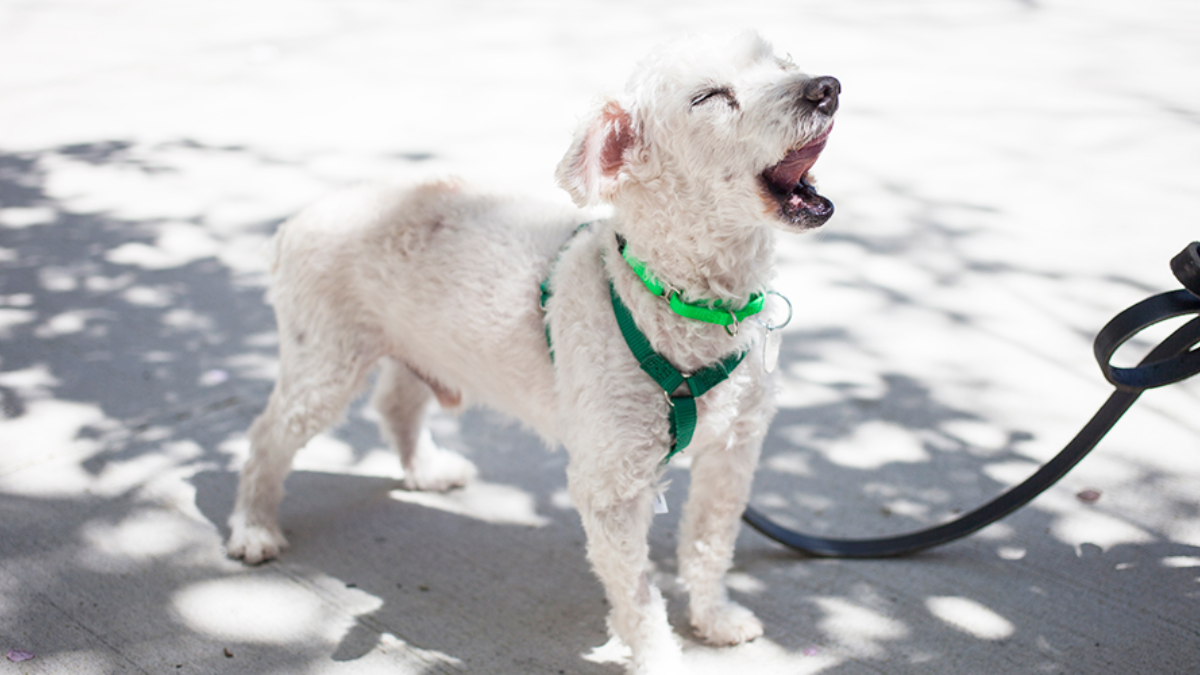Many dog owners have experienced the frustration of their furry friend barking at every little noise. It can be difficult to determine why the dog is barking so much and how to address the behavior. However, understanding the reasons why dogs bark and how they communicate through body language can help owners better manage their pet's behavior. Explore effective strategies to address why your "Dog Barks at Every Noise" and foster a harmonious relationship with your canine companion.

Dogs bark for a variety of reasons, including to alert their owners of potential danger, to communicate with other dogs, or simply out of boredom or anxiety. It's important to observe the context in which the dog is barking to determine the root cause of the behavior. Additionally, dogs communicate not just through vocalizations, but also through body language such as tail wagging, ear position, and posture. Learning to interpret these signals can help owners better understand their dog's behavior.
If left unchecked, excessive barking can become a nuisance to both the dog owner and their neighbors. However, with patience and consistent training, it is possible to teach a dog to bark less and only when necessary. By understanding the reasons behind their dog's barking and communicating with them effectively, owners can help their furry friends become better-behaved and happier companions.
Understanding Dog Barking
Barking is a natural form of communication for dogs, and it can convey a variety of messages. Understanding the reasons behind a dog's barking behavior is essential to address any issues related to excessive barking.
The Basics of Canine Communication
Dogs use body language and vocalizations to communicate with each other and their human companions. Barking is one of the most common forms of vocal communication. The tone, duration, and pitch of a bark can convey different meanings, and it's essential to pay attention to these nuances to understand what a dog is trying to communicate.
Common Causes of Barking
Dogs may bark for a variety of reasons, including anxiety, fear, boredom, stress, territorial barking, and alert barking. Identifying the underlying cause of barking is crucial to address the behavior effectively.
Anxiety and Fear
Dogs that suffer from anxiety or fear may bark excessively as a coping mechanism. These dogs may bark when they are left alone or exposed to loud noises, such as thunderstorms or fireworks.
Boredom
Dogs that are left alone for extended periods may bark out of boredom. Providing adequate mental and physical stimulation can help reduce excessive barking.
Territorial Barking
Dogs may bark to defend their territory or alert their owners to potential threats. This type of barking is often accompanied by other forms of aggressive behavior.

Alert Barking
Dogs may bark to alert their owners to the presence of strangers or other animals. This type of barking is usually short-lived and stops once the perceived threat has passed.
Types of Barking
Dogs may bark in different ways to convey different messages. Some common types of barking include:
Demand Barking
Dogs may bark to demand attention or rewards from their owners. This type of barking can be reduced by ignoring the behavior and rewarding the dog when they are quiet.
Play Barking
Dogs may bark during play as a form of excitement. This type of barking is usually accompanied by other playful behaviors, such as wagging tails and jumping.
Excessive Barking
Dogs that bark excessively may be suffering from an underlying behavioral or medical issue. Consulting with a veterinarian or a professional dog trainer can help identify the cause of excessive barking and develop a plan to address the behavior.
Behavioral Reasons for Barking
Dogs bark for various reasons, and pet owners must understand the underlying causes to address the behavior effectively. Here are some of the most common behavioral reasons for barking in dogs.
Anxiety and Stress
Anxiety and stress can cause dogs to bark excessively. Separation anxiety is one of the most common causes of anxiety in dogs, and it can lead to destructive behavior and excessive barking. Dogs that are anxious or stressed may also bark at every noise or distraction, making it challenging for them to relax.
Boredom and Lack of Stimulation
Dogs that are bored or lack stimulation may bark excessively to get attention or release their energy. Dogs that are left alone for extended periods without any activities or toys may resort to barking to entertain themselves or communicate their boredom.

Fear and Alerting Behaviors
Dogs that are afraid or feel threatened may bark excessively to warn their owners or alert them of potential danger. Fearful dogs may also bark at every noise or distraction to signal their discomfort or distress.
Territorial and Protective Responses
Dogs are territorial animals, and they may bark excessively to protect their territory or family members. Dogs that are not socialized properly may bark at strangers or other animals to establish their dominance or protect their owners.
Understanding the root cause of your dog's barking behavior is crucial to address the issue effectively. Pet owners should provide their dogs with adequate exercise, mental stimulation, and socialization to prevent boredom and anxiety. Additionally, training and positive reinforcement can help curb excessive barking and promote desirable behaviors in dogs.
Training to Reduce Barking
Excessive barking can be a frustrating issue for dog owners. Fortunately, several effective training methods can help reduce barking behavior. Here are some techniques that can be used to train a dog to bark less:
Positive Reinforcement Techniques
Positive reinforcement is a training method that rewards a dog for good behavior. When a dog barks less, they should be rewarded with treats, praise, or playtime. This will help the dog learn that being quiet is a desirable behavior. Positive reinforcement should be used consistently during training sessions to ensure that the dog understands what is expected of them.
Desensitization and Counterconditioning
Desensitization and counterconditioning are techniques used to help a dog become less reactive to certain triggers. For example, if a dog barks at every noise outside, the owner can gradually desensitize the dog to those noises by playing recordings of the sounds at a low volume and gradually increasing the volume over time. Counterconditioning involves pairing the trigger (the noise) with a positive experience, such as treats or playtime. Over time, the dog should learn to associate the noise with positive experiences and become less reactive.
Alternative Behavior Training
Teaching a dog an alternative behavior to barking can be an effective way to reduce barking behavior. For example, teaching a dog to "speak" on cue and then teaching them to "quiet" on cue can help them learn to control their barking. This technique can be reinforced with positive reinforcement, such as treats or praise.
Consistency in Training
Consistency is key when it comes to training a dog to bark less. Owners should be consistent in their training methods and use positive reinforcement consistently during training sessions. It is also important to be consistent in enforcing rules and boundaries. If a dog is allowed to bark at certain times but not others, it can be confusing for the dog and make training less effective.
Professional dog trainers can be a valuable resource for owners who are struggling to train their dogs to bark less. A professional trainer can help identify the underlying causes of barking behavior and develop a customized training plan to address those issues. With patience and consistency, most dogs can be trained to bark less and become better-behaved pets.
Environmental Management
Minimizing Exposure to Triggers
One of the most important steps in managing a dog that barks at every noise is to minimize their exposure to triggers. This can be achieved by identifying the specific triggers that set off the dog and taking steps to reduce their exposure to them. For example, if the dog barks at noises outside, closing windows and doors or using soundproof curtains can help reduce the amount of noise that enters the house.
Another way to minimize exposure to triggers is to limit the dog's access to certain areas of the house. For instance, if the dog barks at noises coming from the front yard, keeping them in a back room or using a baby gate to block off the front of the house can be helpful.
Creating a Calm Environment
Creating a calm environment is crucial for managing a dog that barks at every noise. This can be achieved by providing the dog with a comfortable and safe space where they can relax. A comfortable bed, toys, and treats can help create a positive association with the space and reduce anxiety.
It is also important to avoid punishing the dog for barking. Punishment can increase anxiety and make the problem worse. Instead, focus on positive reinforcement and reward the dog for calm behavior.
Use of Distractions and White Noise
Distractions and white noise can be effective tools for managing a dog that barks at every noise. Providing the dog with mental stimulation through interactive toys or puzzles can help distract them from outside noises.

White noise machines or calming music can also help drown out outside noises and create a more peaceful environment for the dog.
In conclusion, managing a dog that barks at every noise requires a multi-faceted approach that includes minimizing exposure to triggers, creating a calm environment, and using distractions and white noise. By implementing these strategies, owners can help their dogs feel more comfortable and reduce excessive barking.
Addressing Specific Noises
Dogs that bark at every noise can be a nuisance to both the owners and the neighbors. Addressing specific noises that trigger barking can help reduce the frequency of barking and improve the overall behavior of the dog. Here are some tips on how to address specific noises that may cause your dog to bark excessively.
Doorbell and Visitors
When the doorbell rings or visitors arrive, dogs may bark excessively out of excitement or fear. To address this behavior, it is important to teach your dog a command such as "quiet" or "stay" to help them remain calm. You can also train your dog to associate the doorbell or visitors with positive experiences such as treats or playtime. Additionally, you can use a leash to control your dog's behavior when visitors arrive.
Cars and Passersby
Dogs may bark at cars and passersby due to their territorial nature or fear of strangers. To address this behavior, you can train your dog to associate cars and passersby with positive experiences such as treats or playtime. You can also use a leash to control your dog's behavior when walking near busy streets or areas with high foot traffic. Additionally, providing your dog with a designated area to observe outside activity can help reduce their need to bark.

Household Noises and Appliances
Household noises and appliances such as vacuum cleaners, blenders, and washing machines can be a source of anxiety for some dogs. To address this behavior, you can gradually expose your dog to these noises and appliances in a positive and controlled manner. You can also provide your dog with a designated safe space such as a crate or a quiet room away from the noise. Additionally, using white noise or calming music can help drown out the noise and reduce your dog's anxiety.
By addressing specific noises that trigger barking, you can help reduce the frequency of barking and improve the overall behavior of your dog. With consistent training and patience, your dog can learn to remain calm and quiet in various situations.
Tools and Aids for Managing Barking
Excessive barking can be a nuisance for both the dog owner and their neighbors. Fortunately, there are several tools and aids available to help manage barking behavior.
Bark Collars and Deterrents
Bark collars and deterrents are devices that can be used to discourage barking. These devices use various methods such as citronella spray, ultrasonic sound, or mild electric shocks to interrupt barking behavior. It is important to note that bark collars and deterrents should only be used as a last resort and under the guidance of a professional trainer or veterinarian.
Puzzle Toys and Enrichment Activities
Dogs that bark out of boredom or frustration can benefit from puzzle toys and enrichment activities. These toys and activities provide mental stimulation and can keep dogs occupied for extended periods. Examples of puzzle toys include treat-dispensing toys, puzzle feeders, and interactive toys. Enrichment activities can include hide-and-seek games, scent work, and agility training.

Professional Help and Dog Walkers
In cases where barking is a symptom of separation anxiety or other behavioral issues, professional help may be necessary. A certified dog trainer or behaviorist can assess the dog's behavior and create a customized training plan to address the underlying issue. Additionally, hiring a dog walker or pet sitter can help alleviate separation anxiety and provide much-needed exercise and socialization for the dog.
It is important to remember that barking is a natural behavior for dogs and can have various causes such as fear, playfulness, or alertness. Punishing a dog for barking can lead to further frustration and anxiety. Instead, owners should focus on redirecting their dog's behavior by providing alternative behaviors and positive reinforcement. Providing distractions such as peanut butter-filled toys during stressful events like fireworks or guests can also help reduce barking behavior.
Preventing Excessive Barking
Excessive barking can be a nuisance for both the dog and its owner. Luckily, there are several ways to prevent this behavior from becoming a problem. In this section, we will discuss some effective methods for preventing excessive barking in dogs.
Early Socialization and Training
Early socialization and training are crucial for preventing excessive barking in dogs. Socializing a puppy from a young age helps them to become comfortable with different people, animals, and environments. This can reduce anxiety and fear, which are common causes of excessive barking.
Training is also important for teaching a dog to control their barking. Basic obedience training can help a dog learn to follow commands and understand when barking is appropriate. Teaching a dog to "speak" and "quiet" on command can also help control their barking.
Routine and Predictability
Dogs thrive on routine and predictability. Establishing a consistent daily routine can help reduce anxiety and stress, which can lead to excessive barking. Providing a predictable environment with regular feeding times, exercise, and playtime can help a dog feel more secure and less likely to bark excessively.
Recognizing and Addressing Needs
Excessive barking can often be a sign that a dog has unmet needs. Dogs may bark excessively when they are hungry, thirsty, bored, or in need of exercise or attention. Owners need to recognize and address these needs to prevent excessive barking.

Desensitization can also help reduce excessive barking. This involves exposing a dog to the stimuli that trigger their barking in a controlled and gradual manner. Over time, the dog can become desensitized to these stimuli and their barking can be reduced.
In conclusion, preventing excessive barking in dogs requires a combination of prevention, socialization, consistency, and addressing the root cause of the behavior. By following these methods, owners can help their dogs become well-behaved and happy members of the family.
Conclusion:
In conclusion, addressing the issue of a dog barks at every noise, requires a combination of understanding, patience, and proactive training. Identifying the root cause of the behavior is crucial, whether it's fear, territorial instincts, or simply boredom. Through positive reinforcement techniques and consistent training, owners can teach their dogs alternative behaviors and gradually desensitize them to triggering noises. Creating a calm and predictable environment, along with providing mental and physical stimulation, can also help reduce excessive barking. Additionally, seeking guidance from a professional dog trainer or behaviorist can offer valuable insights and tailored solutions. It's important to remember that modifying behavior takes time and dedication, and there may be setbacks along the way. However, with perseverance and a compassionate approach, owners can effectively manage their dog's barking and foster a more peaceful living environment for both the dog and their human companions. By addressing the issue of a dog barking at every noise with patience and understanding, owners can strengthen their bond with their furry friend and create a harmonious home environment.
Frequently Asked Questions (FAQs)
- How can I train my dog to be less reactive to noises?
- Training your dog to be less reactive to noises requires patience, consistency, and positive reinforcement. One effective method is desensitization training, where you gradually expose your dog to the sounds that trigger their barking and reward them for remaining calm. Another approach is counter-conditioning, where you associate the noise with something positive, such as treats or playtime. It is important to seek the guidance of a professional dog trainer if you are unsure how to proceed.
- What are effective methods to reduce alarm barking in dogs?
- Effective methods to reduce alarm barking in dogs include providing adequate exercise and mental stimulation, teaching your dog a "quiet" command, and addressing any underlying anxiety or fear issues. It is important to avoid punishment-based methods, as these can lead to further behavioral issues.
- Why is my dog excessively barking at night and how can I address it?
- Dogs may bark excessively at night due to boredom, anxiety, or a need for attention. Addressing the underlying cause is key to reducing this behavior. Providing your dog with plenty of exercise and mental stimulation during the day, creating a comfortable sleeping environment, and avoiding reinforcing the behavior by giving attention when your dog barks can all help to reduce nighttime barking.
- Are there any anti-barking devices that are safe and humane for dogs?
- There are some anti-barkinganti-barking devices that are safe and humane for dogs, such as citronella collars or ultrasonic devices. However, it is important to use these devices under the guidance of a professional and to avoid relying solely on them to address the underlying behavioral issue.
- What steps should I take if my dog barks at every sound in an apartment setting?
- If your dog barks at every sound in an apartment setting, it is important to address the underlying cause of the behavior. Providing your dog with plenty of exercise and mental stimulation, teaching a "quiet" command, and desensitization training can all help to reduce excessive barking. It is also important to be considerate of your neighbors and address any noise complaints promptly.
- Is it possible to stop a dog from barking in seconds, and what techniques work best?
- It is not realistic to expect to stop a dog from barking in seconds, as this behavior is often deeply ingrained and requires consistent training and reinforcement. Techniques such as desensitization training, counter-conditioning, and positive reinforcement are all effective methods for reducing excessive barking. It is important to seek the guidance of a professional dog trainer if you are struggling to address this behavior.




